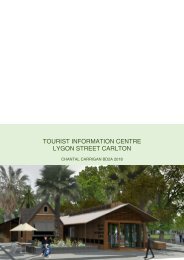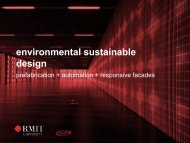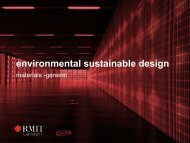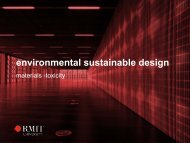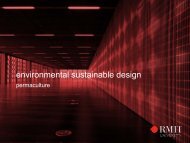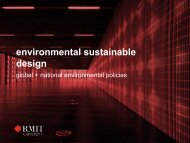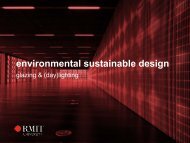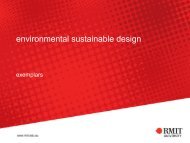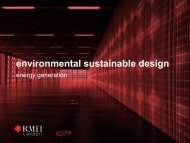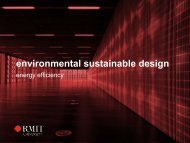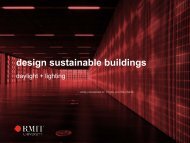#Site Recording + Climate Zones
You also want an ePaper? Increase the reach of your titles
YUMPU automatically turns print PDFs into web optimized ePapers that Google loves.
environmental sustainable<br />
design<br />
climate zones + recording
Site <strong>Recording</strong><br />
12/9/18 Architecture & Design 2
solar passive design<br />
Follow the sun,<br />
Observe the wind,<br />
Watch the flow of water,<br />
Use simple materials,<br />
Touch the earth lightly.<br />
- Glenn Murcutt<br />
12/9/18 Architecture & Design 3
solar passive design<br />
process<br />
• Connectivity<br />
• Project<br />
• Site<br />
• Community<br />
• Ecology<br />
• Indigenous<br />
• existing<br />
• Long Life/ Loose Fit<br />
• Design for the future/ reflect the past<br />
• Context<br />
• +1 scale<br />
12/9/18 Architecture & Design 4
Site <strong>Recording</strong><br />
genus of place<br />
• observation<br />
• recording<br />
• response<br />
12/9/18 Architecture & Design 5
Site <strong>Recording</strong><br />
12/9/18 Architecture & Design 6
Site <strong>Recording</strong><br />
• topography<br />
• solar access<br />
• views<br />
• site access<br />
12/9/18 Architecture & Design 7
Site <strong>Recording</strong><br />
Site record existing conditions in more than just plan view<br />
12/9/18 Architecture & Design 8
Site <strong>Recording</strong><br />
Sunlight<br />
• A north facing slope receives more solar<br />
radiation than a level site, which is<br />
important during winter when the sun<br />
angle is low (ASPECT)<br />
• South facing slopes over 10% or facing<br />
within 45° of south are generally<br />
unsuitable for successful passive solar<br />
applications.<br />
• Any overshadowing by hills, trees or<br />
existing buildings will affect the amount of<br />
light available. Define large or nearby<br />
obstructions, even those to the south of<br />
the site.<br />
12/9/18 Architecture & Design 9
Site <strong>Recording</strong><br />
Wind<br />
• Wind speeds on the crest of a hill may be 20%<br />
greater than on flat ground<br />
• At night time the cold air will tend to move<br />
downwards on exposed slopes, while the air is<br />
warmer higher up<br />
• A slight wind even on calm days is<br />
characteristic of sea-coasts or lake shores,<br />
(evaporation/ transpiration/ convection)<br />
• Deep valleys or long straight avenues can<br />
funnel and accelerate wind speeds (Urban +<br />
Open)<br />
• High buildings can create localised high wind<br />
speed and turbulence.<br />
• speed<br />
• direction<br />
• frequency<br />
12/9/18 Architecture & Design 10
Site <strong>Recording</strong><br />
Summary<br />
Site analysis checklist<br />
• Air temperatures / monthly mean temperatures for day and night<br />
• Daylight: obstructions on or near the site that may affect the availability of light<br />
• Sunlight: note slope and orientation of the site; maximum potential hours of sunlight<br />
based on climate data; sun angles based on site latitude; any overshadowing<br />
• Wind: the wind rose for the area will give the directions and frequencies of the prevailing<br />
winds, but note the degree of exposure and local effects due to topography<br />
• Topography: obstructions on the site can deflect the wind and provide shelter, but they<br />
may create overshadowing<br />
• Structures: detail any structures which can be re-used and soil, stone or timber on the<br />
site that can be used for construction, landscaping or shelter<br />
• Vegetation: note the type, size and condition of trees, shrubs, shelter belts, crops,<br />
ground cover<br />
• Water: note the level of the water table and the existing pattern of water movement<br />
• Soil: note type and firmness which may affect foundations, drainage and planting<br />
• Air quality and noise levels: note aspects which will impact ventilation options<br />
• Site area: note space availability for on-site waste recycling or digestion, for<br />
permaculture, for biomass or food production<br />
• Hazards: record contaminated soil or ground water, radon or electromagnetic radiation<br />
sources, water retention<br />
• Views: views from, of, or through the site may deserve preservation or exploitation<br />
• Human and vehicular movement patterns.<br />
12/9/18 Architecture & Design 11
Site <strong>Recording</strong><br />
client/ site selection<br />
● Does the location suit their current lifestyle?<br />
● Can the site continue to accommodate changes over time?<br />
o employment opportunities/ financial position<br />
o health<br />
o recreational focus<br />
o family situation<br />
o retirement<br />
● Travel Costs<br />
o work, school, exercise, shop, socialise or get health care?<br />
o Proximity to services?<br />
● What type of home?<br />
critical questions to augment the recording of site features<br />
12/9/18 Architecture & Design 12
Location<br />
To correctly determine location a site's Latitude(red), and Longitude (blue)<br />
must be known.<br />
It's important to remember that even though the lat/long grid on the flat map<br />
looks like a grid of squares, it isn't that way on the real Earth (see the sphere<br />
above).<br />
The distance between one-degree lines depends on where you are. It's<br />
largest at the Equator and smallest at the Poles.<br />
text and images from University of Tasmania<br />
12/9/18 Architecture & Design 13
Location<br />
Time <strong>Zones</strong><br />
The standard Melbourne time zone is +9 UTC (Coordinated Universal Time)<br />
During the summer months the time shifts forward +1 hour. (+10)<br />
When working on virtual environment software it is important to take this into account. Some<br />
programs time stamp a watermark onto animations that may be misleading to clients when<br />
replayed.<br />
Greenwich Mean Time (GMT) is a term originally referring to mean solar time at the Royal<br />
Observatory in Greenwich, London.On 1 January 1972, GMT was replaced as the international<br />
time reference by Coordinated Universal Time, (UTC) maintained by an ensemble of atomic<br />
clocks around the world. -wikipedia<br />
12/9/18 Architecture & Design 14
Location<br />
<strong>Climate</strong> <strong>Zones</strong><br />
12/9/18 Architecture & Design 15
Location<br />
<strong>Climate</strong> <strong>Zones</strong> BCA<br />
12/9/18 Architecture & Design 16
Location<br />
<strong>Climate</strong> <strong>Zones</strong> NCC<br />
12/9/18 Architecture & Design 17
Location<br />
Microclimate<br />
Locations<br />
Different layouts<br />
result in differing<br />
microclimates,<br />
providing greater or<br />
lesser comfort.<br />
• Regional<br />
• Sub-urban<br />
• Urban<br />
Heat Island Effect<br />
Typically, daily mean<br />
temperatures are 1-<br />
2°C higher; more on<br />
a still summer<br />
evening.<br />
12/9/18 Architecture & Design 18





